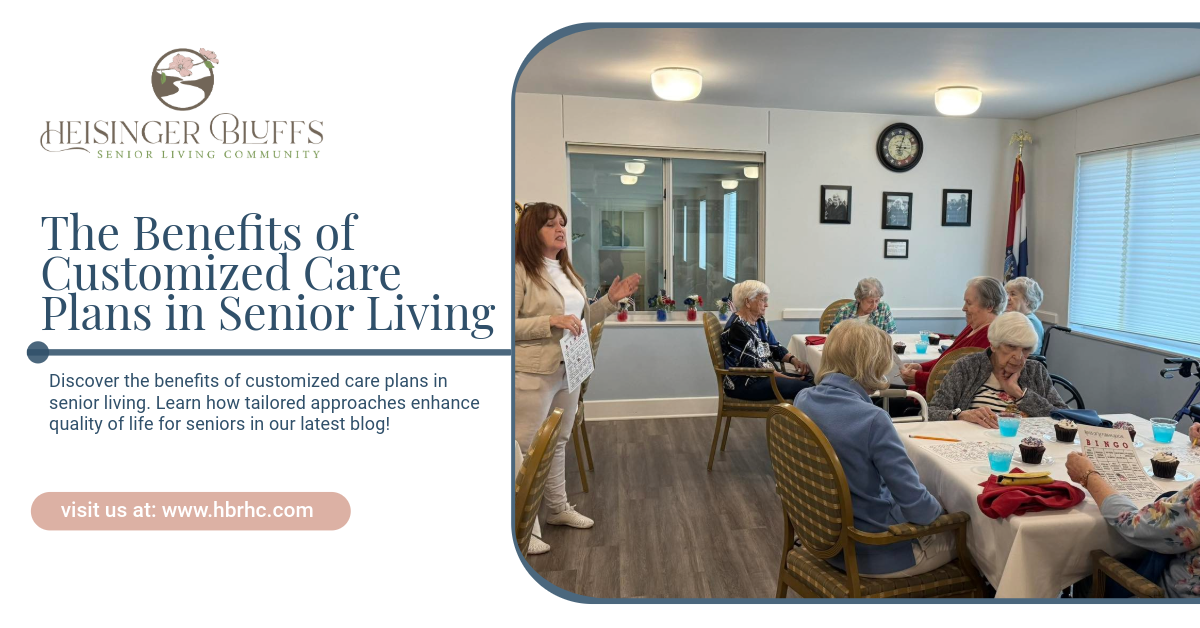The Benefits of Customized Care Plans in Senior Living

Key Highlights
- Each personalized care plan in senior living is carefully crafted to address the unique needs of older adults, ensuring their comfort and dignity.
- Moving away from a one-size-fits-all model, these plans focus on improving quality of life by tailoring daily routines to individual preferences.
- They promote better health outcomes by prioritizing physical and mental well-being through specialised care.
- Family members and healthcare professionals collaborate in the planning process, fostering trust and ensuring holistic support.
- Seniors maintain their independence and autonomy, gaining a sense of control over their lives through customized care plans.
- Designed to enhance daily living, personalized care plans cater to seniors’ health and emotional needs, enabling them to thrive.
Senior living communities are changing how they care for people by making personalized care plans. These plans are made for each person. They look at the health conditions, wants, and the way of life of older adults living there. By focusing to each person's needs, the plans help seniors have a better quality of life. They also help them keep their independence and dignity.
In this blog, we’ll talk about what makes these care plans stand out, the good things they bring, and how working together helps make life better for older adults. These personalized plans are at the heart of great senior living.
Understanding Customized Care Plans in Senior Living
Customized care plans in senior living address each individual's unique needs. Care providers assess preferences and health conditions to deliver tailored support, including assistance with daily activities and medication management. By considering mental health and emotional well-being, older adults can maintain their independence.
This holistic approach leads to improved health outcomes and a better quality of life, providing peace of mind for both seniors and their families. These plans ensure that every individual feels supported and valued in their living environment.
What Defines a Customized Care Plan for Seniors?
A personalized care plan begins by assessing each senior's needs, including physical health and daily routines. For instance, some may require assistance with medication management or nutrition.
Flexibility is crucial; as a senior’s health evolves, so too does their support. The plan may focus on memory care for those with Alzheimer’s or cater to active seniors wishing to stay fit. Individual preferences shape the care provided.
Daily routines are vital as the care team aligns support with what seniors enjoy or need help with, such as meal preparation, physical therapy, or social engagement. This tailored approach enhances health and quality of life, ensuring individuals receive optimal support for their best days possible.
Key Differences Between Standardized and Personalized Care
Standardized senior care is not always right because it treats everyone the same and it does not take into account what each person needs. In senior care, personalized care stands out because it is more flexible and more focused on who the person is. This kind of care looks at someone's health, but also what they want from life and what their habits are.
To help make this clear, look at the comparison here:
| Feature | Standardized Care | Personalized Care |
|---|---|---|
| Approach | One-size-fits-all | Tailored to individual needs |
| Activities Offered | Generic, not always accessible | Customized to personal interests |
| Medical Strategy | Uniform treatments | Specific health assessments and plans |
| Independence | Limited freedom | Promotes autonomy |
When care is personalized, seniors can have a higher quality of life. The care they get matches what they want to do and what they hope for. This is a big difference, and it shows why a more tailored kind of senior care is so important in senior living communities. This approach can give better health outcomes and help the people living there get more from life.
Core Advantages of Personalized Care for Seniors
A personalized care plan helps with senior care. It puts focus on comfort and things that matter to each person. This way, a care plan meets all the needs of the senior. It helps make sure that health goals are reached and long-term well-being is looked after.
When care is made just for each person, older adults see better physical health. They also feel stronger, more independent, and happier. This personalized care plan builds trust between those who give care and those who receive it. As a result, seniors get more than basic support. The care plan gives them a better life. Seniors feel sure of themselves and more in control every day.
Enhanced Health Outcomes and Well-being
Personalized care plans improve health outcomes for seniors by addressing their unique medical issues, daily routines, and specific challenges. This tailored approach not only reduces hospital visits but also enhances overall health.
Moreover, these plans support mental well-being by incorporating enjoyable activities and emotional support, leading to greater happiness among seniors. Research shows that meeting emotional needs significantly boosts their quality of life.
Additionally, personalized care promotes equity in healthcare by addressing access disparities. By considering individual backgrounds, these plans ensure that all seniors receive appropriate support, fostering an inclusive environment where they feel valued and cared for.
Promoting Independence and Dignity
Independence is crucial in senior care. Customized care plans empower older adults to control their daily lives by incorporating preferred activities like meal prep and games, allowing them to make choices.
With appropriate support, seniors can manage tasks independently or with minimal assistance, preserving their dignity and enhancing their quality of life. These adaptable plans ensure that care evolves with their changing needs.
Personalized routines foster a sense of pride, ensuring that care is tailored to the individual. Balancing independence and dignity enables older adults to approach each day feeling strong and confident.
Family Involvement and Collaboration in Care Planning
Family members play an important role when making special care plans for seniors. Their thoughts about the person’s feelings and daily habits help make sure the care fits what the senior really wants and needs.
Working together with healthcare professionals makes the care even better. Mixing the know-how of experts and what the family has to say helps create a full plan that keeps seniors happy and healthy. When families get involved in this way, they can have peace of mind, knowing that their loved ones are truly being cared for.
Role of Family Members in Developing Care Plans
Family involvement ensures care plans align with seniors' needs. Families contribute their feelings and ideas, helping staff understand how to best meet each individual's requirements. Collaborating creates strategies that reflect a person's values and daily life.
When families participate in planning, it fosters trust and provides peace of mind, knowing the care plan is tailored for their loved one. Their involvement also offers seniors vital emotional support, enhancing their sense of security.
In summary, family engagement improves care plans by addressing not only health outcomes but also emotional and social needs. When families and care providers collaborate, the plans become stronger and more reliable.
Collaborative Approach with Healthcare Professionals
Healthcare professionals play a crucial role in developing and modifying care plans for individuals. Their medical expertise is vital for managing chronic conditions, and input from various specialists ensures comprehensive coverage of a person's health.
Effective collaboration leads to clear plans that include medication management, therapy sessions, and preventive measures. This multi-step approach ensures each aspect of seniors' health receives proper attention, enhancing daily routines and long-term care.
Collaboration also facilitates adjustments when a senior's health changes. Care providers and families can adapt plans to meet evolving needs, ensuring continuous, high-quality care.
Final Thoughts
Customized care plans are essential for enhancing seniors' quality of life. By focusing on individual needs and preferences, these plans improve health outcomes while preserving dignity and promoting independence. Collaboration between family members and healthcare professionals ensures tailored support for each person.
At Heisinger Bluffs, we recognize the importance of personalized plans and are committed to providing the best care. Contact us today to learn how our personal care plans can benefit your loved ones!
Frequently Asked Questions
How are individualized care plans created for each resident?
Care providers create plans for each person after looking at their health, what they want, and what is best for them. Families and those who give care work together to find the best ways to help with unique needs. They also change how they care for someone as their health or goals change. This way, seniors can get care that fits them best.
Can family members participate in the care planning process?
Yes, family members are asked to join in making care plans. Their input helps the plan fit real needs and what each person likes. This way, it gives peace of mind and helps build trust between families and caregivers.
How do personalized care plans support seniors with chronic conditions?
Tailored care empowers seniors to manage their health effectively. It addresses chronic conditions and offers personalized medication management and therapy. These plans aim to reduce symptoms and prevent hospital visits, enabling seniors to achieve better health outcomes and maintain independence. Additionally, the care plans provide support and tips aligned with their lifestyles and future goals.
Sources:
- https://www.alz.org/alzheimers-dementia/facts-figures
- https://www.nia.nih.gov/health/assisted-living-and-nursing-homes/long-term-care-facilities-assisted-living-nursing-homes
- https://www.ncoa.org/article/the-top-10-most-common-chronic-conditions-in-older-adults/
- https://pmc.ncbi.nlm.nih.gov/articles/PMC10548654/











